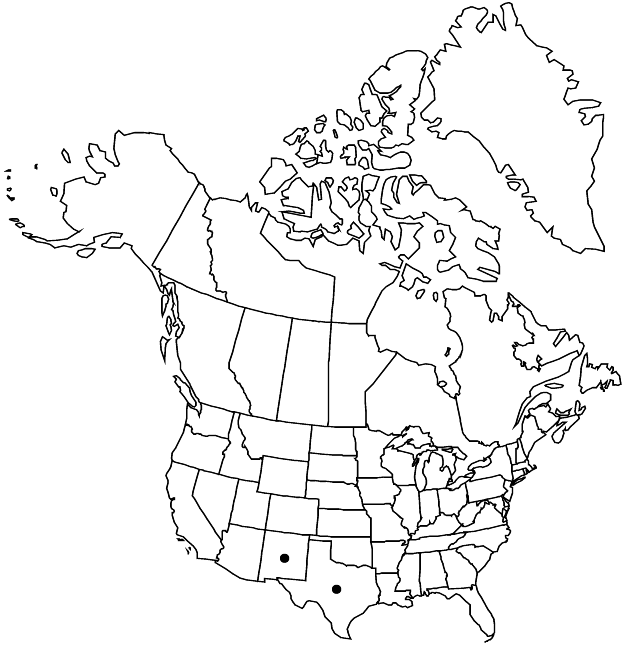Difference between revisions of "Eriogonum havardii"
Proc. Amer. Acad. Arts 18: 194. 1883.
FNA>Volume Importer |
imported>Volume Importer |
||
| (2 intermediate revisions by one other user not shown) | |||
| Line 8: | Line 8: | ||
}} | }} | ||
|common_names=Havard’s wild buckwheat | |common_names=Havard’s wild buckwheat | ||
| + | |special_status={{Treatment/ID/Special_status | ||
| + | |code=E | ||
| + | |label=Endemic | ||
| + | }} | ||
|basionyms= | |basionyms= | ||
|synonyms={{Treatment/ID/Synonym | |synonyms={{Treatment/ID/Synonym | ||
|name=Eriogonum leucophyllum | |name=Eriogonum leucophyllum | ||
|authority=Wooton & Standley | |authority=Wooton & Standley | ||
| + | |rank=species | ||
}} | }} | ||
|hierarchy=Polygonaceae;Polygonaceae subfam. Eriogonoideae;Eriogonum;Eriogonum subg. Eucycla;Eriogonum havardii | |hierarchy=Polygonaceae;Polygonaceae subfam. Eriogonoideae;Eriogonum;Eriogonum subg. Eucycla;Eriogonum havardii | ||
| Line 36: | Line 41: | ||
-->{{#Taxon: | -->{{#Taxon: | ||
name=Eriogonum havardii | name=Eriogonum havardii | ||
| − | |||
|authority=S. Watson | |authority=S. Watson | ||
|rank=species | |rank=species | ||
| Line 50: | Line 54: | ||
|publication title=Proc. Amer. Acad. Arts | |publication title=Proc. Amer. Acad. Arts | ||
|publication year=1883 | |publication year=1883 | ||
| − | |special status= | + | |special status=Endemic |
| − | |source xml=https:// | + | |source xml=https://bitbucket.org/aafc-mbb/fna-data-curation/src/2e0870ddd59836b60bcf96646a41e87ea5a5943a/coarse_grained_fna_xml/V5/V5_563.xml |
|subfamily=Polygonaceae subfam. Eriogonoideae | |subfamily=Polygonaceae subfam. Eriogonoideae | ||
|genus=Eriogonum | |genus=Eriogonum | ||
Latest revision as of 22:12, 5 November 2020
Herbs, erect, not scapose, (2–)3–6 × 1.5–4 dm, glabrous, grayish. Stems spreading, without persistent leaf bases, up to 1/5 height of plant; caudex stems absent; aerial flowering stems erect, slender, solid, not fistulose, 0.5–2.5 dm, glabrous, tomentose among leaves. Leaves basal, 1 per node; petiole 0.5–1.5(–2.5) cm, tomentose; blade oblanceolate to elliptic, 1–3(–5) × 0.2–1(–1.3) cm, densely white- or silvery-tomentose on both surfaces, margins plane. Inflorescences cymose, open, divided 3–10 times, 10–40 × 10–30 cm; branches dichotomous, glabrous; bracts 3, scalelike, triangular, 1–2 mm. Peduncles erect, slender, 0.5–6 cm. Involucres 1 per node, campanulate, 1.5–2.5 × (1.5–)2–3 mm, tomentose; teeth 5, erect, 0.5–0.8 mm. Flowers 2.5–3 mm; perianth yellow, densely white-pubescent; tepals connate proximal 1/3, monomorphic, lanceolate; stamens exserted, 2.5–3.5 mm; filaments glabrous. Achenes brown, 2–2.5 mm, glabrous. 2n = 40.
Phenology: Flowering May–Sep.
Habitat: Gravelly (often calcareous) or shaley to clayey or gypsum flats and outcrops, mixed grassland, creosote, and mesquite communities, juniper woodlands
Elevation: (400-)800-1800(-2100) m
Discussion
Eriogonum havardii is infrequent in southeastern New Mexico (Chaves, Eddy, Lea, Lincoln, Otero, and Socorro counties) and western Texas (Brewster, Culberson, El Paso, Hudspeth, Pecos, Presidio, Terrell, Val Verde, and Winkler counties). The leaf blades are demarcated by depressed lines along their entire length, appearing as a series of folds. The bright yellow of the flowers is seen only by looking at the adaxial surface of the tepals, the abaxial surface being wholly obscured by dense white hairs. The species is worthy of cultivation.
Selected References
None.
